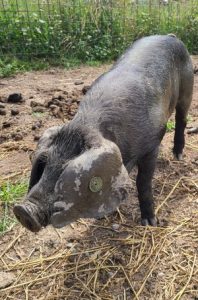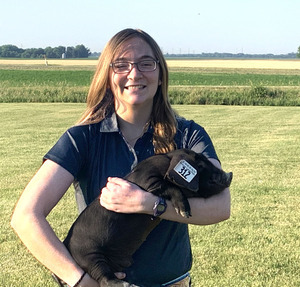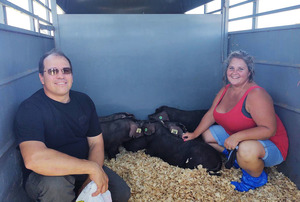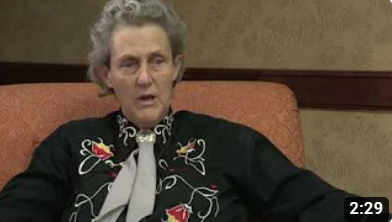FOR IMMEDIATE RELEASE
Contact: Brittany Sweeney
bsweeney@LivestockConservancy.org
(919) 542-5704
Pittsboro, N.C. [August 20, 2020] – The first critically-endangered Large Black piglets bred from frozen, imported semen were born in the United States this summer. After years of extensive collaborative efforts from many organizations, new life and new genetics are being introduced to American Large Black Hog herds thanks to 25 half-British Large Black piglets born at Purdue University.
Solid black, deep-bodied swine with lop ears that cover their eyes, Large Blacks have long been prized for their docile nature, superior mothering abilities and succulent pork. Despite these qualities, the Large Black Hog is in global danger of extinction. Fewer than 150 purebred animals were registered in the United States in 2019. Through partnerships with breeders, universities, private donors, USDA, industry leaders and food organizations, The Livestock Conservancy is working to save this unique breed for future farming generations.
Small populations, like the Large Black, can quickly lose genetic diversity and suffer from inbreeding depression. This can lead to declines in fitness traits, including reproductive ability. To infuse new genetics into this U.S. heritage swine population, The Livestock Conservancy imported frozen semen from two Large Black boars from the U.K. in 2015. Importation was made possible by a significant gift from an anonymous donor, several additional private donations, as well as partnerships with the USDA’s National Animal Germplasm Program (NAGP), Large Black Hog Association, Gloucestershire Old Spots America, British Pig Association, and Deerpark Pedigree Pigs of the U.K.
The Livestock Conservancy and NAGP subsequently conducted inseminations during several on-farm trials. Despite efforts of the best swine reproduction specialists in the U.S. and participating farmers who have worked with this breed for decades, none of these attempts produced live piglets. The experts soon realized heritage breed pig reproductive cycling is different from commercial pigs, where artificial insemination is common.
Dr. Kara Stewart, assistant professor of Animal Sciences at Purdue University with a specialty in reproductive physiology, and graduate student Katharine Sharp, began exploring methods to control and synchronize ovulation of Large Black sows to identify ideal times for insemination. Thawed semen is only viable for a short time period, so predictable timing of ovulation and insemination is critical to the successful use of frozen semen. Twenty Large Black female pigs were donated to The Livestock Conservancy from breeders across the nation and were transported from their home farms to Purdue University in 2018 to launch this research.
“When I heard that The Livestock Conservancy was having trouble finding enough girls for this research project, I thought I would donate four sisters that were weaned and ready to go,” said Felicia Krock, registrar and secretary of the Large Black Hog Association and a member of The Livestock Conservancy. “I thought if there were issues with the bloodline it would raise its ugly head through the use of three of my girls who were full siblings and one who was a half sibling to them. This was such a great opportunity to enhance the survivability of a very special breed.”
For nearly two years, Purdue scientists studied female reproduction for the breed, first using less expensive frozen semen from U.S. pigs to test their insemination protocols. The researchers refined a Large Black sow cycling protocol that allowed them to predict ovulation, thaw semen at just the right time, and inseminate the females. Each insemination trial at Purdue saw greater improvements in the rate of conception and number of live births. Pigs produced from these trials were used in further research projects to document growth and meat characteristics for the endangered breed.
The next, and most expensive, step was using the frozen, imported semen to create half-British and half-American piglets. The hard work paid off. Half-British piglets were born in May 2020 from five sows. The little boars and gilts are being distributed across the U.S. to broaden the genetic base for the Large Black breed.
“Preservation of heritage breeds is important to help maintain the genetic diversity of our livestock,” said David Burgett, a member of both The Livestock Conservancy and the Large Black Hog Association, who recently received a few of the piglets at his Illinois farm. “Having dwindled to such a small population, the Large Black Hog, through years of inbreeding with the limited number of bloodlines available in the United States, was in danger of losing some of the diverse traits inherent to specific blood lines. With the importation of British bloodlines comes the responsibility to work together as members of the Large Black Hog Association to improve the herd, to promote the breed and the characteristics that make it unique and so desirable, and build the population back up to avoid its extinction. We are grateful that we had this chance to participate in the joint project with The Livestock Conservancy and Purdue University to improve the future, and promote the survival of the Large Black Hog.”
A second breeding with imported semen will be conducted this fall to produce more piglets. Researchers plan to share their research results and techniques with farmers, enabling them to do on-farm artificial insemination and produce their own Large Black breeding stock. These new techniques for using frozen semen on heritage breed pigs will allow Large Black boar semen to be more widely exchanged among the nation’s breeders to keep their herds genetically healthy. The new frozen semen protocols may be useful for other heritage pig breeds, as well.
The Livestock Conservancy’s Swine Initiative with Large Black pigs illustrates the power of collaboration and technology to advance rare breed conservation.
Learn more about Large Black pigs at http://bit.ly/LargeBlackPigs
Livestock Conservancy Swine Initiative Timeline
2008 – In November, a Rare Breed Swine Initiative Meeting was held at the National Small Farms Trade Show and Conference in Columbia, MO. The meeting was organized by The Livestock Conservancy and supported by the Renewing America’s Food Traditions (RAFT) collaborative. Eleven rare swine breeds are currently listed on The Livestock Conservancy’s Conservation Priority List and each heritage pig breed was represented by a breeder or breed association. This collaborative meeting was a step toward understanding the specific conservation challenges of heritage swine breeds.
2011-2014 – Through funding from the Southern Sustainable Agriculture Research and Education Program (SSARE), The Livestock Conservancy collaborated with rare breed associations, producers, Virginia Tech University, University of Missouri, University of Kentucky, Purdue University, Berea College, and Agriculture and Agri-Food Canada’s Canadian Animal Genetic Resources to study growth, meat characteristics, marketing, and genetic diversity for eight heritage breeds of pigs. This work alerted collaborators that several pig breeds were coming to a critical point in their genetic diversity in the United States. Additional revitalization efforts were needed to avoid inbreeding bottlenecks that could cripple producers’ efforts with rare breeds.
2015 – The Livestock Conservancy imported frozen semen from two Large Black and two Gloucestershire Old Spots boars from the U.K. Importation was made possible by a significant gift from an anonymous donor, donations from breeders including Ruth Blaney from New York and Kimberly Ruessler from Florida, as well as partnerships with national and international collaborators.
2015-2018 – The Livestock Conservancy and NAGP conducted inseminations through several on-farm trials. None of the attempts produced live piglets. Swine reproduction specialists and participating farmers discovered heritage breed pig reproductive cycling is different from commercial pigs, where artificial insemination is common.
2018-2020 – Dr. Kara Stewart, assistant professor of Animal Sciences at Purdue University, and graduate student Katharine Sharp, explored methods to control and synchronize ovulation of Large Black sows to identify ideal insemination times with frozen semen.
2020 – The first critically-endangered heritage breed piglets bred from frozen, imported semen were born in the U.S. in May. New life and new genetics are being introduced to American Large Black Hog herds as 25 half-British Large Black piglets are distributed to breeders. A second breeding with imported semen will be conducted in the fall.
Future – Researchers plan to share their heritage swine reproduction techniques with farmers, enabling them to do on-farm artificial insemination and produce more genetically healthy Large Black Hog breeding stock. These new techniques for using frozen semen will allow Large Black boar semen to be more easily exchanged among the nation’s breeders. The new protocols may also be useful for other heritage pig breeds.
###
Photo credits: First photo features a half British/half American Large Black piglet courtesy of Felicia Krock. Second photo features Purdue University graduate student Katharine Sharp holding one of the half British/half American Large Black piglets courtesy of Purdue University. Third photo features Felicia and Darren Krock picking up half British/half American Large Black piglets for their farm Triangle K Ranch, courtesy of Purdue University. Fourth photo features a half British/half American boar and gilt at home on David Burgett’s farm in Illinois, courtesy of David Burgett.
###
About The Livestock Conservancy
The Livestock Conservancy is America’s leading organization working to protect over 150 heritage breeds of livestock and poultry from extinction. Included in its mission are: donkeys, cattle, goats, horses, sheep, pigs, rabbits, chickens, ducks, geese and turkeys. Founded in 1977, the non-profit is a pioneer organization working to conserve historic breeds and genetic diversity in U.S. livestock. The Livestock Conservancy’s mission is to protect endangered livestock and poultry breeds from extinction.
Why is genetic diversity important?
Like all ecological systems, agriculture depends on genetic diversity to adapt to an ever-changing environment. Genetic diversity in domestic animals is revealed in distinct breeds, each with different characteristics and uses.
Traditional, historic breeds retain essential attributes for survival and self-sufficiency – fertility, foraging ability, longevity, maternal instincts and resistance to disease and parasites. As agriculture changes, this genetic diversity may be needed for a broad range of uses and opportunities. Once lost, genetic diversity is gone forever.
What Are Heritage Breeds?
Heritage breeds are traditional livestock breeds that were raised by our forefathers. These are the breeds of a bygone era, before industrial agriculture became a mainstream practice. These breeds were carefully selected and bred over time to develop traits that made them well-adapted to the local environment and they thrived under farming practices and cultural conditions that are very different from those found in modern agriculture.
Heritage animals once roamed America’s pastoral landscape, but today these breeds are in danger of extinction. Modern agriculture has changed, causing many of these breeds to fall out of favor. Heritage breeds store a wealth of genetic resources that are important for our future and the future of our agricultural food system.







